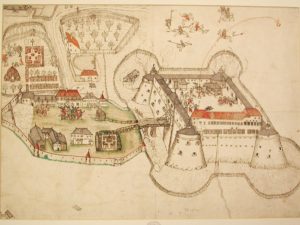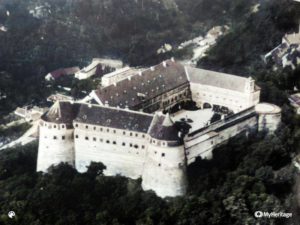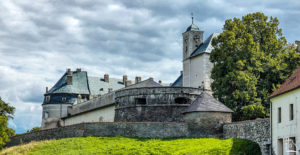Vöröskő

Vöröskő castle is located in the Upper lands/Horná zem/Felföld. It is in Slovakia, and in Slovakian, it is called Hrad Červený Kameň. This is a lucky Hungarian castle in the Small-Carpathian mountains because it has remained in the most intact and best condition. It is only 30 km from Pozsony, situated on a 340-meter-high hill. This castle’s task was to guard the trade routes between Pozsony (Pressburg, Bratislava) and Bohemia. Vöröskő was one of the defense castles ranging from Pozsony to Zsolna (Zilina) that were defending the Hungarian Kingdom’s borders against the western attackers.

King Béla III (1148-1196) gave Vöröskő castle to his daughter, Constancia, as a wedding gift when she wed King Ottokar I, the Bohemian ruler. One of the legends of the castle is connected to Constancia, too. Initially, she had wanted to have the castle built a bit further to the east but the fairies advised her otherwise. Finally, she was persuaded by the locals that she should take the advice of the fairies. Behold, the “fairies” were not always friendly creatures in Hungarian folk tales and mythology. Finally, Constancia built the castle in the recommended place so the bad spirits could never harm the castle anymore. Allegedly, it was the fairies’ reward that this castle could remain intact until our days.

According to another legend, twelve wise men were deciding upon the castle’s location. Eleven of them said it should be built on the top of Kukla Hill which is on the other side of the castle that we can see today. Only one wise man, the 12th of them recommended the present site for building up Vöröskő castle. He tried to convince the others that evil spirits were haunting the summit of Kukla Hill each night. He claimed that the noise of the construction might be unnerving to them. However, the majority of the wise men disregarded his opinion.
The work began, and the foundation was laid. But a strange thing was happening at night: the stone foundation was lifted by the fairies who took the stones to the other hill. The next morning, the masons could not find the stones. It made the wise men reconsider their decision, and they continued the construction on the second site.
As for sure, we know that it was indeed Queen Constancia who had Vöröskő constructed in 1240, after King Ottokar’s death. She spent the rest of her life among the walls. Upon her death, Vöröskő castle was given to Count Tamás, son of Tibor (Tiborc). However, he could not enjoy his property for long. Soon, Count Tamás happened to fabricate false accusations against a nobleman called Count Marton, son of Turnyi Domonkos. His charges proved to be false, and Devecheri Eimech Márton, Vice-Judge of Hungary decided to compensate Count Marton with half of the castle. Thus, the ownership over Vöröskő castle was divided between them.

Count Marton didn’t like this situation, and he bartered Vöröskő with Master Mátyás, son of Csáky Péter, in exchange for 200 “heavy silver Marks” in 1269. Master Mátyás was the Count of Trencsén castle, and Palatine-Comes of Hungary at the same time, the lord of the Vág River’s Valley. Soon, during the reign of King Vencel, King Ottó, and King Károly I, he became known as Csák Máté, a very powerful oligarch of Northern Hungary. When he died, Vöröskő and all his domains were inherited by the Hungarian king, though. (Please, note that I use the Oriental name order for Hungarians where family names come first.)

Vöröskő was in the hand of Wolfart Ulrich in 1350. However, it was King Zsigmond who took Vöröskő back from a Moravian man, Count Prokop. It must have been given back to the Wolfart family because we know, that Lady Wolfart Judit wed Count Szentgyörgyi György of Bazin castle in 1441. She brought Vöröskő and Magyaróvár castles into the marriage. Vöröskő castle was inherited by Szapolyai György and János in 1511, according to the Last Will of Count Szentgyörgyi Péter. Yet, everything was inherited by King Lajos II in 1516. The young king gave the castle to his wife, Habsburg Maria.

We know that the Fugger banker family had a dirty hand in sabotaging Hungary before the Battle of Mohács: they were angry with the young king because he had quit the disastrous contract with them. In the case of King Lajos’ death, they knew that Habsburg Ferdinand would get the throne of Hungary which would grant the Fuggers all the rights they needed. Ferdinand was the brother of Maria, Queen of Hungary. The party of Habsburg Maria insisted on not making peace with the Turks and the Queen sent his King against the invading Ottoman army. Neither Ferdinand nor his brother, Emperor Charles gave any military help to King Lajos. Only Queen Maria sent her own bodyguard to take care of the king’s life…

As it turned out, both King Lajos II and Szapolyai György died in the Battle of Mohács in 1526, and the Dual Kingship tore the kingdom into two parts. The usurper Ferdinand ruled the western lands, and King Szapolyai the eastern part of the kingdom. The proud and strong castle of Vöröskő fell into the hands of the Thurzó family in 1526. Thurzó Elek (1490-1543) and János were the new owners, they were loyal to Ferdinand. Few know that the Thurzó family was the second richest family in Europe because they were related to the Fugger banker family because Thurzyó III György wed Lady Anna Fugger. The Thurzó and the Fugger family were tied together with the marriage. But was it good for Hungary?

Together with the Fuggers, they were running the copper mines in Upper Hungary. They had trade monopolies in Krakow, Nünberg, and Lőcse (Levoca). The Fuggers had almost no competitors in Europe to distribute copper between 1494 and 1526. Anton Fugger (1493–1560) purchased the copper empire from Thurzó Elek for 105,401 gold Forints in 1528. Copper was one of the most important elements for making firearms. The copper mines of Hungary provided 40% of the copper that was sold in Europe. You can read more about the fabulous North Hungarian Mining Towns here:
https://www.hungarianottomanwars.com/essays/the-mining-towns-of-upper-hungary/
Anton Fugger had Europe’s biggest storage chamber built under the castle of Vöröskő, according to Italian designs. It was 72 meters long and 9 meters high and contained two stories. The Fuggers began to rebuild the castle totally in 1535. Besides copper, they stored wine and food there as well. Albrecht Dürer, the famous artist whose family had come from the Hungarian village called Ajtós near Gyula castle, also worked on the designs of the castle. Read more about Dürer’s Hungarian connections here:
https://www.hungarianottomanwars.com/essays/albrecht-durer-1471-1528-and-hungary/

The best Italian builders were there, too. There was Mester János (Giovanni) among them, the famous Italian architect who had worked in Pozsony previously. After 20 years of building, Vöröskő became a strong Renaissance-style fort, with a square plan and round bastions. Allegedly, there was only one similar fort in Europe that was capable of storing as many tons of products as Vöröskő could, it was a castle in Switzerland on the top of the Schaffhausen Hill, built between 1564 and 1582.

Anton Fugger died in 1560. It is said that the empire that he left behind was in peril because of Sultan Suleiman’s onslaught and because of the debates between his heirs who wanted to inherit the Fuggers’ wealth. Vöröskő castle was gifted to the famous general and aristocrat, Pálffy Miklós in 1581. It was because he had wed Maria Fugger. To own the whole dominion, he paid 94,012 gold Rhine Forints to the Fuggers in 1588 which was considered a bargain, compared to the previous price that Anton Fugger had paid for it. Now, the Fuggers were related to the Thurzó and the Pálffy families as well, both were true followers of the Habsburgs.

Pálffy and his wife beautified the castle but even the income of the rich dominion was not enough to cover the costs. So the Fuggers of Augsburg had to support them with further funds. Pálffy was given the title of a Count by King Rudolf II for the retaking of Győr city in 1599. The cold castle became a luxuriously supplied and decorated beautiful palace between the 17th and the 18th century. You can read more about Pálffy Tamás, one of the members of the Pálffy family here:
https://www.hungarianottomanwars.com/essays/palffy-tamas-1534-1581-a-hungarian-hero/

The dominion around the castle had 18 settlements: Cseszte, Alsódiós, Ompital, Szuha, Bogdanócz, Borova, Dubova, Helmes, Hosszúfalu, Istvánfalva, Kápolna, Kosolna, Klucsován, Pila, Gidrafa (Pudmeric), Selpicz, Kárpáthalas, and Harangfalva. Prince Thököly Imre’s troops occupied the castle in 1683 because it opened its gates. However, General Kollonich Zsigmond took it back from them with a trick. Later, due to the Pálffy’s family loyalty to the Habsburgs, their castle was not destroyed in 1701 when the Habsburgs were demolishing many forts of the Hungarian Borderland.

Vöröskő castle remained the property of the Pálffy family until 1945. It was the year when all of their properties were confiscated by the state. To give you a hint, here are the most significant of the castles, domains, or palaces of the Pálffy family that were taken away from them:
The Pálffy family had hereditary offices in Árva, Bajmóc, Bazin, Bény, Borostyánkő, Dettrekő, Dévény, Fehérkő, Feketenyék, Gidrafa, Jókő, Királyfa, Nyitra, Malacka, and in Pozsony. They had palaces in four places: Szentgyörgy, Szomolány, Trencsén, and in Vöröskő. These were taken away until 1949 but their palaces in Hungary in Lovasberény, Gönc, Visegrád, and Vác have also fallen into the hands of the state. Now, there is an exhibition about the Pálffy family in Vöröskő castle. Sadly, there is no Hungarian description on the website of Vöröskő (Hrad Červený Kameň).

Dear Readers, I can only make this content available through small donations or by selling my books or T-shirts:
Please, feel free to support me with a coffee here:
You can check out my books on Amazon or Draft2Digital, they are available in hardcover, paperback, or ebook:
https://www.amazon.com/dp/198020490X or at https://books2read.com/b/boYd81

My work can also be followed and supported on Patreon: Become a Patron!http://Become a Patron!

[wpedon id=”9140″]

https://hungarianottomanwars.myspreadshop.com/all



































































